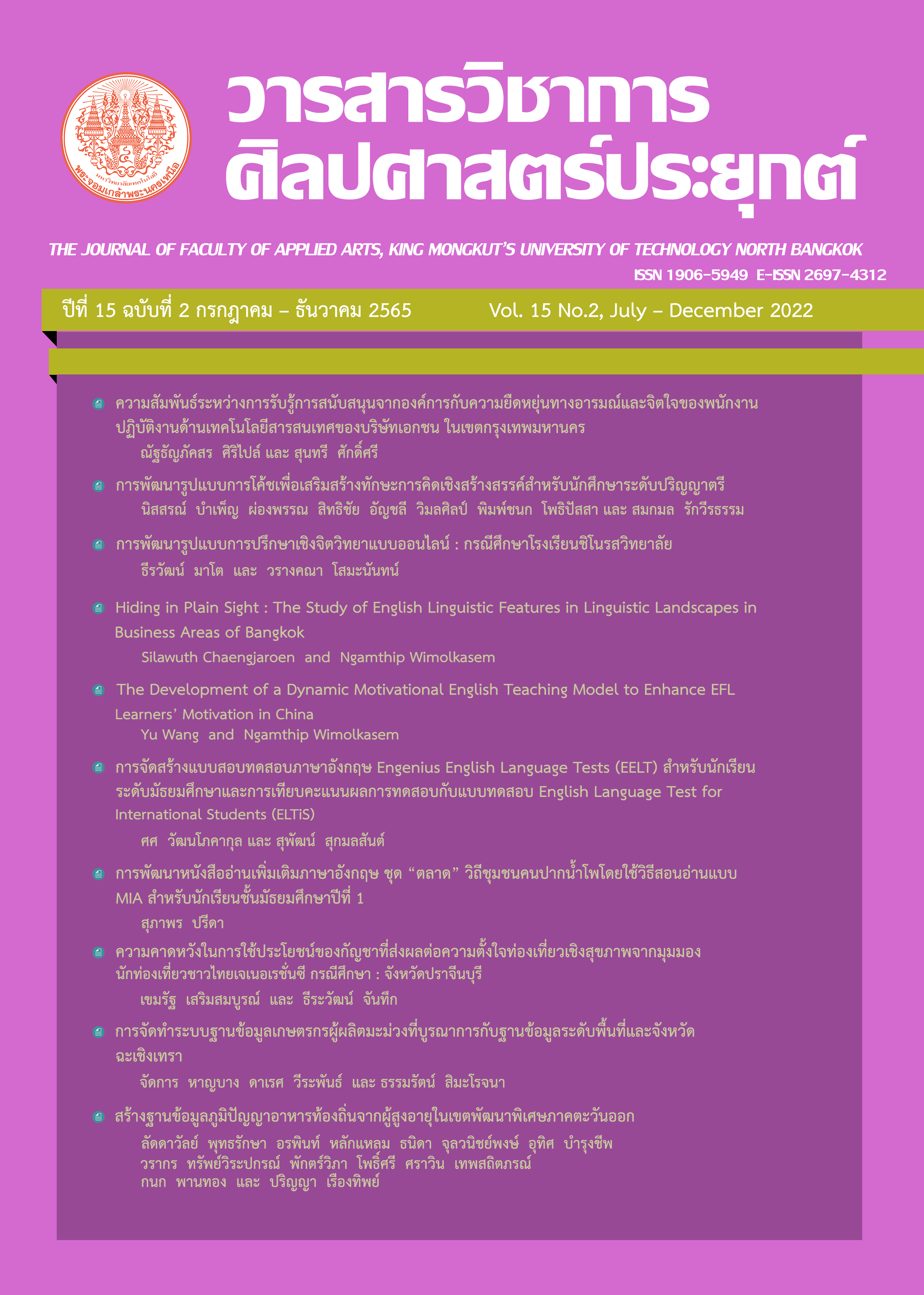“สื่อที่เรามองผ่าน” การศึกษาลักษณะทางภาษาศาสตร์ของภาษาอังกฤษที่ใช้ในภูมิทัศน์ทางภาษาศาสตร์ในย่านธุรกิจของกรุงเทพมหานคร ์None
Main Article Content
บทคัดย่อ
การเรียนรู้ภาษาอังกฤษมิได้เกิดขึ้นเฉพาะในห้องเรียนเท่านั้น แต่ยังพบได้ภายในชุมชนหรือย่านที่อยู่อาศัยของผู้เรียนอีกด้วย เราจึงสามารถพัฒนาการเรียนการสอนภาษาอังกฤษได้โดยใช้แหล่งข้อมูลต่าง ๆ ผ่านภูมิทัศน์ทางภาษาศาสตร์ เช่น ป้ายโฆษณาและป้ายสาธารณะ วิชาการแปลบางวิชาในการเรียนภาษาอังกฤษ มักใช้ตำราเก่าและเนื้อหาไม่ทันสมัย โดยเฉพาะอย่างยิ่งในการแปลโฆษณา ดังนั้น การใช้ภูมิทัศน์ทางภาษาศาสตร์จึงเป็นอีกทางหนึ่งสำหรับผู้ที่ศึกษาภาษาอังกฤษจะได้ใช้สื่อการเรียนการสอนที่มาจากภาษาในสถานการณ์จริง อย่างไรก็ตามภาษาที่ใช้ในภูมิทัศน์ทางภาษาศาสตร์จะต้องผ่านการวิเคราะห์ก่อนที่จะทำมาใช้สอนในห้องเรียน งานศึกษาชิ้นนี้มีวัตถุประสงค์เพื่อสำรวจลักษณะทางภาษาศาสตร์ของภาษาอังกฤษที่ใช้ในภูมิทัศน์ทางภาษาศาสตร์ ได้แก่ รูปแบบการใช้งานของภาษา โครงสร้างทางภาษา ระดับความเป็นทางการของภาษาและภาษาภาพพจน์ ซึ่งใช้ในป้ายโฆษณาต่าง ๆ ในพื้นที่ที่มีความหลากหลายทางภาษาและย่านธุรกิจของกรุงเทพ โดยปรับใช้แนวทางของ แอนดี้ แฮน ค็อก (2555) และทิวาพร ธงทอง (2559) ผลการศึกษาพบว่า รูปแบบการใช้ภาษาอังกฤษส่วนใหญ่ที่ปรากฏในภูมิทัศน์ทางภาษาศาสตร์ คือ รูปแบบการใช้ภาษาแบบให้ข้อมูล ร้อยละ 81 ขณะที่กลุ่มของโครงสร้างภาษามีการใช้วลีถึงร้อยละ 83 อย่างไรก็ตามการใช้ภาษาภาพพจน์ในป้ายโฆษณามีการใช้ภาษาแสดงจินตภาพ เพียงร้อยละ 8 นอกจากนี้ ระดับความเป็นทางการของภาษาที่ใช้ มีการใช้ภาษาแบบไม่เป็นทางการถึงร้อยละ 66 ภาษาที่ใช้ในการสื่อ มีการใช้ภาษาเดียว คือ ภาษาอังกฤษ มากถึงร้อยละ 95 การศึกษานี้ได้นำเสนอข้อมูลใหม่ในเชิงลึกเกี่ยวกับวิธีการใช้คุณลักษณะทางภาษาศาสตร์ของภาษาอังกฤษที่ใช้ในภูมิทัศน์ทางภาษาศาสตร์ซึ่งจะนำไปใช้เป็นสื่อการเรียนการสอนภาษาอังกฤษที่ใช้ในสถานการณ์จริง
Article Details

อนุญาตภายใต้เงื่อนไข Creative Commons Attribution-NonCommercial-NoDerivatives 4.0 International License.
1.บทความที่ตีพิมพ์เป็นลิขสิทธิ์ของวารสารวิชาการศิลปศาสตร์ประยุกต์ การนำเนื้อหา ข้อความหรือข้อคิดเห็น รูปภาพ ตาราง ของบทความไปจัดพิมพ์เผยแพร่ในรูปแบบ ต่าง ๆ เพื่อใช้ประโยชน์ในเชิงพาณิชย์ ต้องได้รับอนุญาตจากกองบรรณาธิการวารสารอย่างเป็นลายลักษณ์อักษร
2.ข้อความที่ปรากฏในบทความแต่ละเรื่อง เป็นความคิดเห็นส่วนตัวของผู้เขียนแต่ละท่านไม่เกี่ยวข้องกับวารสารวิชาการศิลปศาสตร์ประยุกต์ และบุคลากร คณาจารย์ท่านอื่น ๆ ในวารสารฯ แต่อย่างใด ความรับผิดชอบองค์ประกอบทั้งหมดของบทความแต่ละเรื่องเป็นของผู้เขียนแต่ละท่าน หากมีความผิดพลาดใด ๆ ผู้เขียนแต่ละท่านจะรับผิดชอบบทความของตนเองแต่ผู้เดียว
เอกสารอ้างอิง
Chesnut, M., Lee, V., & Schulte, J. (2013). The Language Lessons around Us: Undergraduate English Pedagogy and Linguistic Landscape Research. English Teaching: Practice and Critique, 12(2), 102-120.
Dancygier, B., & Sweetser, E. (2014). Figurative language. Cambridge University Press.
Kachru, B. B. (1990). The alchemy of English: The spread, functions, and models of non-native Englishes. University of Illinois Press.
Kachru, B. B. (2006). The English language in the outer circle. World Englishes, 3, 241-255.
Landry, R., & Bourhis, R. Y. (1997). Linguistic landscape and ethnolinguistic vitality: An empirical study. Journal of language and social psychology, 16(1), 23-49.
Gorter, D., & Cenoz, J. (2014). Linguistic landscapes inside multilingual schools. In Challenges for language education and policy (pp. 163-181). Routledge.
Hancock, A. (2012). Capturing the linguistic landscape of Edinburgh: A pedagogical tool to investigate student teachers’ understandings of cultural and linguistic diversity. Linguistic landscapes, multilingualism and social change, 249-266.
Hill, J., & Miller, K. B. (2013). Classroom instruction that works with English language learners. ASCD.
Lakoff, G., & Johnson, M. (2008). Metaphors we live by. University of Chicago press.
Rowland, L. (2013). The pedagogical benefits of a linguistic landscape project in Japan. International Journal of Bilingual Education and Bilingualism, 16(4), 494-505.
Sawant, D. G., & Hingoli, D. STYLISTIC ISSUES IN TRANSLATING.
Thongtong, T. (2016). A linguistic landscape study of signage on Nimmanhemin road, A Lanna Chiang Mai chill-out Street. MANUSYA: Journal of Humanities, 19(3), 72-87.
Verhelst, N., Van Avermaet, P., Takala, S., Figueras, N., & North, B. (2009). Common European Framework of Reference for Languages: learning, teaching, assessment. Cambridge: Cambridge University Press


